M&S Marketing Audit: Strategy, Market Position, Segmentation & Growth
VerifiedAdded on 2024/06/28
|20
|4511
|365
Report
AI Summary
This report provides a comprehensive marketing audit of Marks & Spencer (M&S), evaluating its current market position and marketing strategy. The audit includes a PESTEL analysis, Porter's Five Forces analysis, and an examination of M&S's marketing mix (4Ps). It assesses the macro and task environments, marketing organization, systems, and productivity. The report also proposes relevant market segmentation strategies for M&S, suggests suitable research for business growth with chosen customer segments, and demonstrates an understanding of buyer behavior to fulfill segment requirements. Ultimately, the report aims to provide insights into enhancing M&S's marketing performance and achieving sustainable growth in the retail industry.
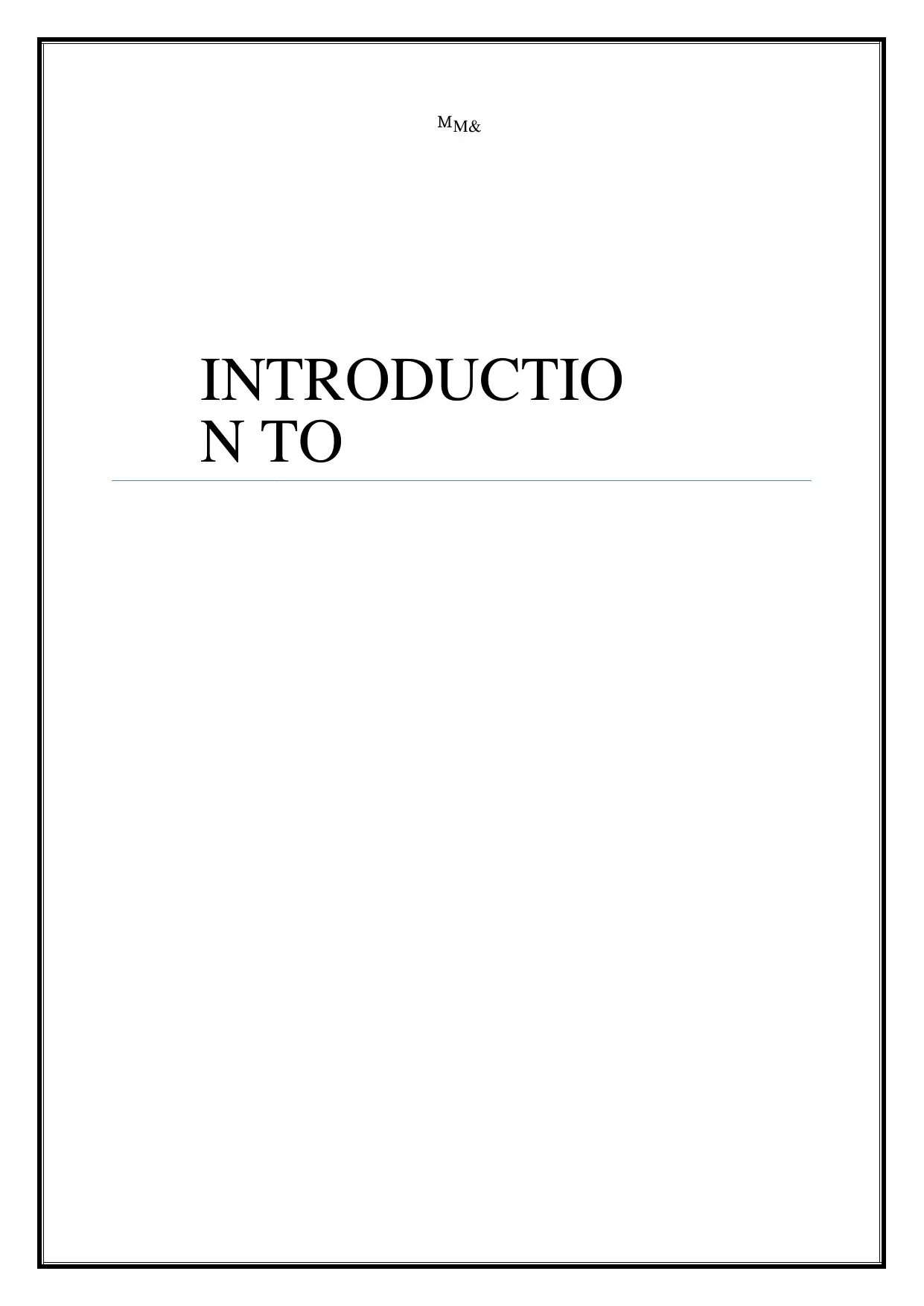
M
Paraphrase This Document
Need a fresh take? Get an instant paraphrase of this document with our AI Paraphraser
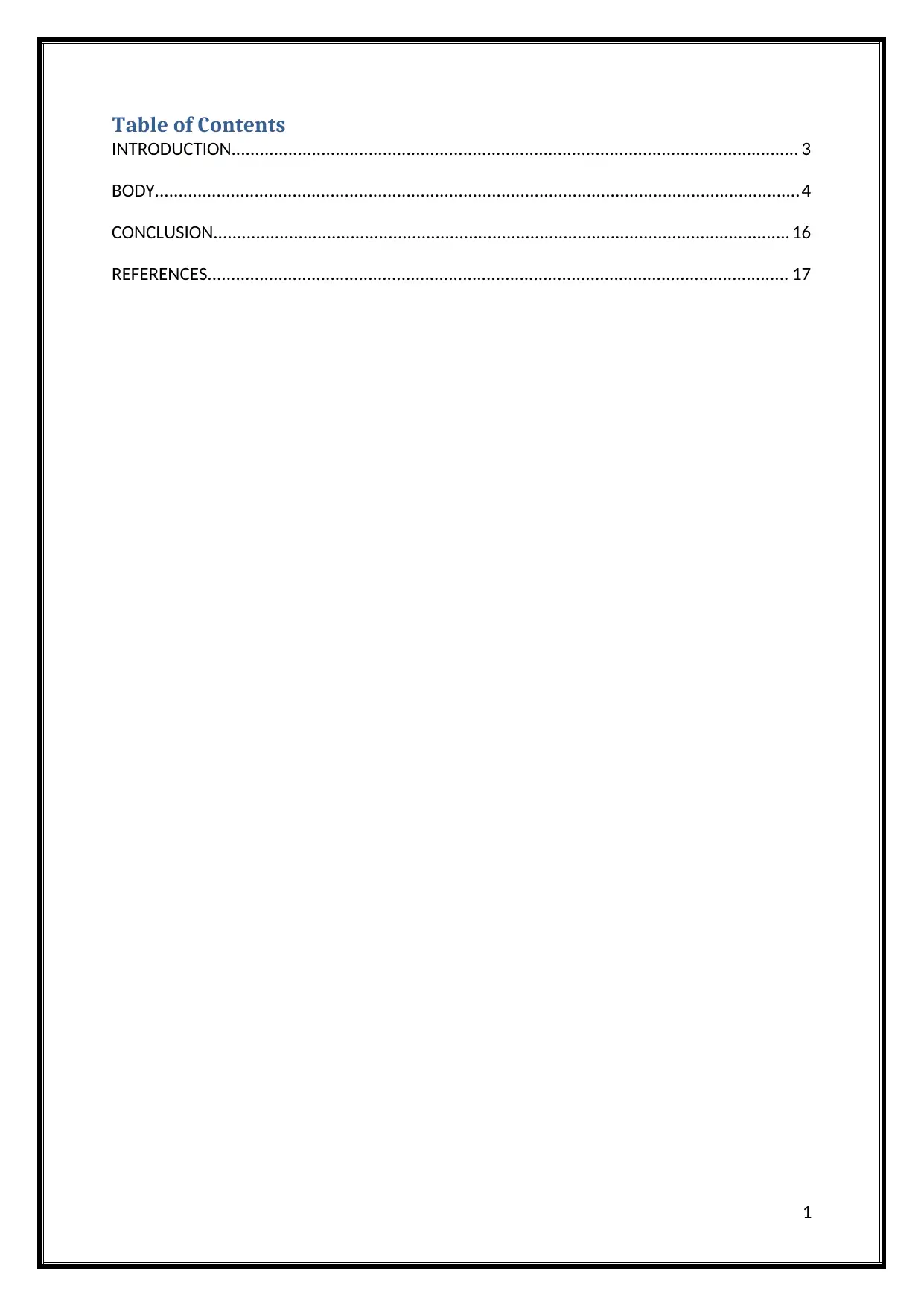
Table of Contents
INTRODUCTION........................................................................................................................ 3
BODY........................................................................................................................................4
CONCLUSION.......................................................................................................................... 16
REFERENCES........................................................................................................................... 17
1
INTRODUCTION........................................................................................................................ 3
BODY........................................................................................................................................4
CONCLUSION.......................................................................................................................... 16
REFERENCES........................................................................................................................... 17
1
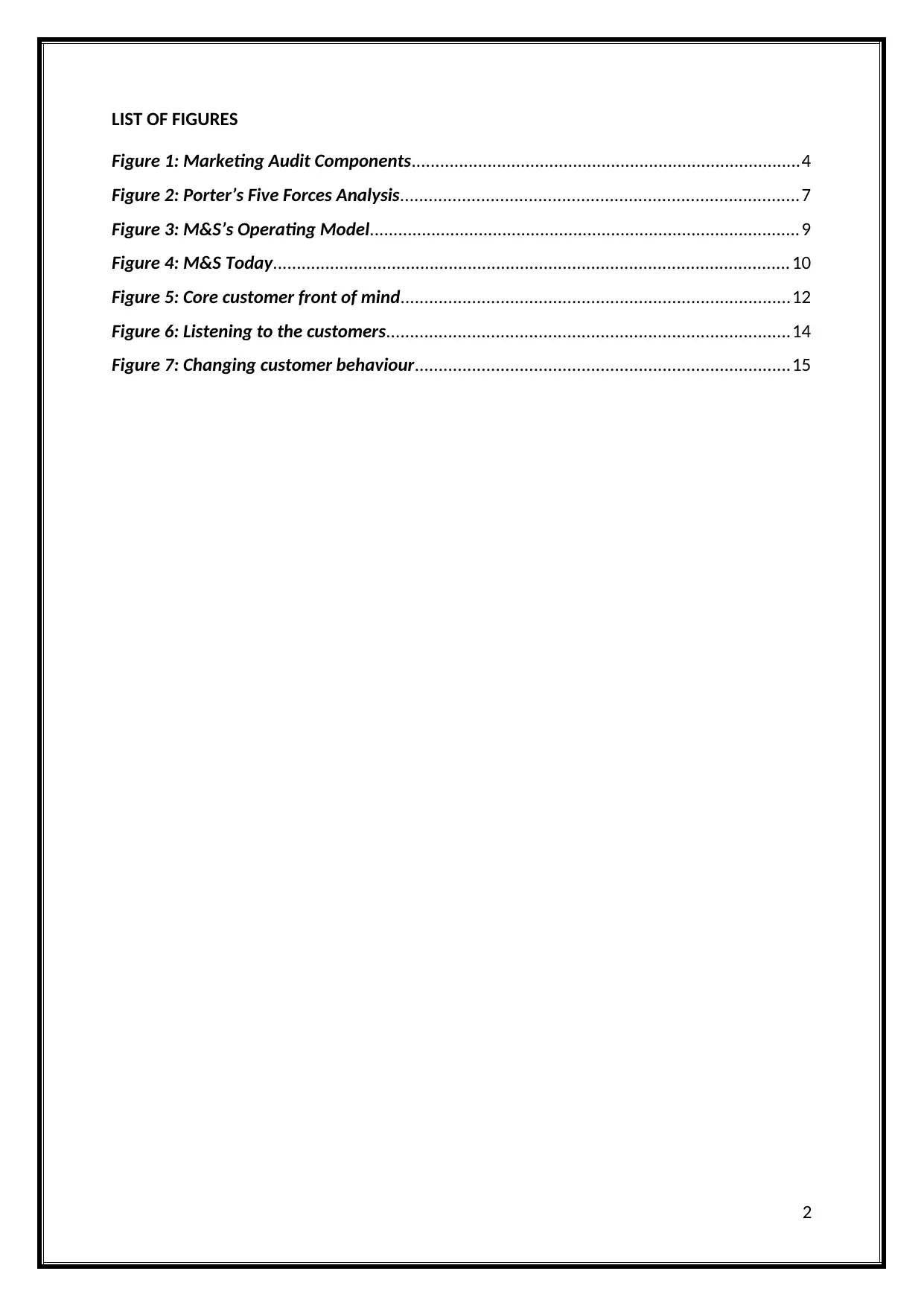
LIST OF FIGURES
Figure 1: Marketing Audit Components..................................................................................4
Figure 2: Porter’s Five Forces Analysis....................................................................................7
Figure 3: M&S’s Operating Model...........................................................................................9
Figure 4: M&S Today............................................................................................................. 10
Figure 5: Core customer front of mind..................................................................................12
Figure 6: Listening to the customers.....................................................................................14
Figure 7: Changing customer behaviour...............................................................................15
2
Figure 1: Marketing Audit Components..................................................................................4
Figure 2: Porter’s Five Forces Analysis....................................................................................7
Figure 3: M&S’s Operating Model...........................................................................................9
Figure 4: M&S Today............................................................................................................. 10
Figure 5: Core customer front of mind..................................................................................12
Figure 6: Listening to the customers.....................................................................................14
Figure 7: Changing customer behaviour...............................................................................15
2
⊘ This is a preview!⊘
Do you want full access?
Subscribe today to unlock all pages.

Trusted by 1+ million students worldwide
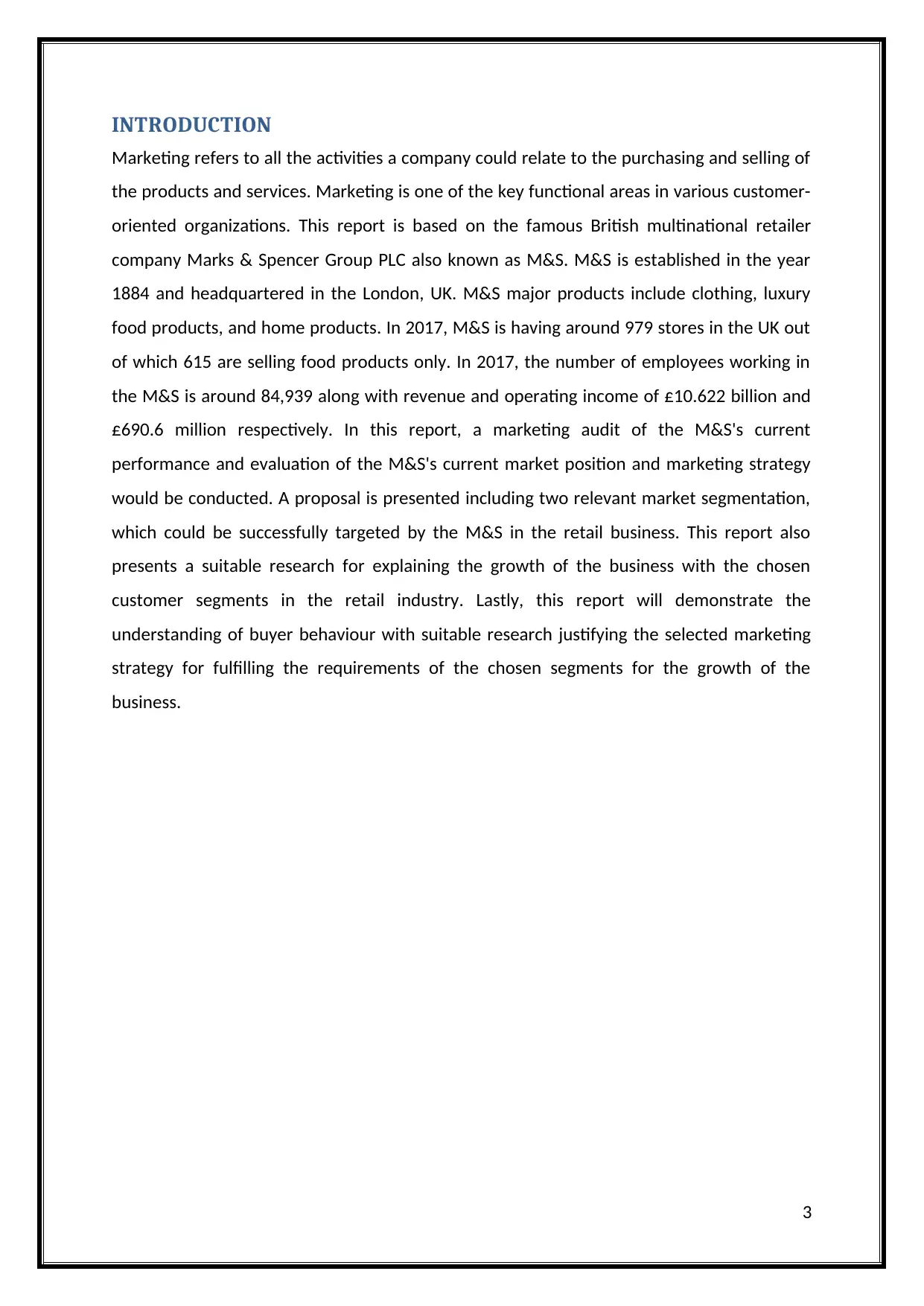
INTRODUCTION
Marketing refers to all the activities a company could relate to the purchasing and selling of
the products and services. Marketing is one of the key functional areas in various customer-
oriented organizations. This report is based on the famous British multinational retailer
company Marks & Spencer Group PLC also known as M&S. M&S is established in the year
1884 and headquartered in the London, UK. M&S major products include clothing, luxury
food products, and home products. In 2017, M&S is having around 979 stores in the UK out
of which 615 are selling food products only. In 2017, the number of employees working in
the M&S is around 84,939 along with revenue and operating income of £10.622 billion and
£690.6 million respectively. In this report, a marketing audit of the M&S's current
performance and evaluation of the M&S's current market position and marketing strategy
would be conducted. A proposal is presented including two relevant market segmentation,
which could be successfully targeted by the M&S in the retail business. This report also
presents a suitable research for explaining the growth of the business with the chosen
customer segments in the retail industry. Lastly, this report will demonstrate the
understanding of buyer behaviour with suitable research justifying the selected marketing
strategy for fulfilling the requirements of the chosen segments for the growth of the
business.
3
Marketing refers to all the activities a company could relate to the purchasing and selling of
the products and services. Marketing is one of the key functional areas in various customer-
oriented organizations. This report is based on the famous British multinational retailer
company Marks & Spencer Group PLC also known as M&S. M&S is established in the year
1884 and headquartered in the London, UK. M&S major products include clothing, luxury
food products, and home products. In 2017, M&S is having around 979 stores in the UK out
of which 615 are selling food products only. In 2017, the number of employees working in
the M&S is around 84,939 along with revenue and operating income of £10.622 billion and
£690.6 million respectively. In this report, a marketing audit of the M&S's current
performance and evaluation of the M&S's current market position and marketing strategy
would be conducted. A proposal is presented including two relevant market segmentation,
which could be successfully targeted by the M&S in the retail business. This report also
presents a suitable research for explaining the growth of the business with the chosen
customer segments in the retail industry. Lastly, this report will demonstrate the
understanding of buyer behaviour with suitable research justifying the selected marketing
strategy for fulfilling the requirements of the chosen segments for the growth of the
business.
3
Paraphrase This Document
Need a fresh take? Get an instant paraphrase of this document with our AI Paraphraser
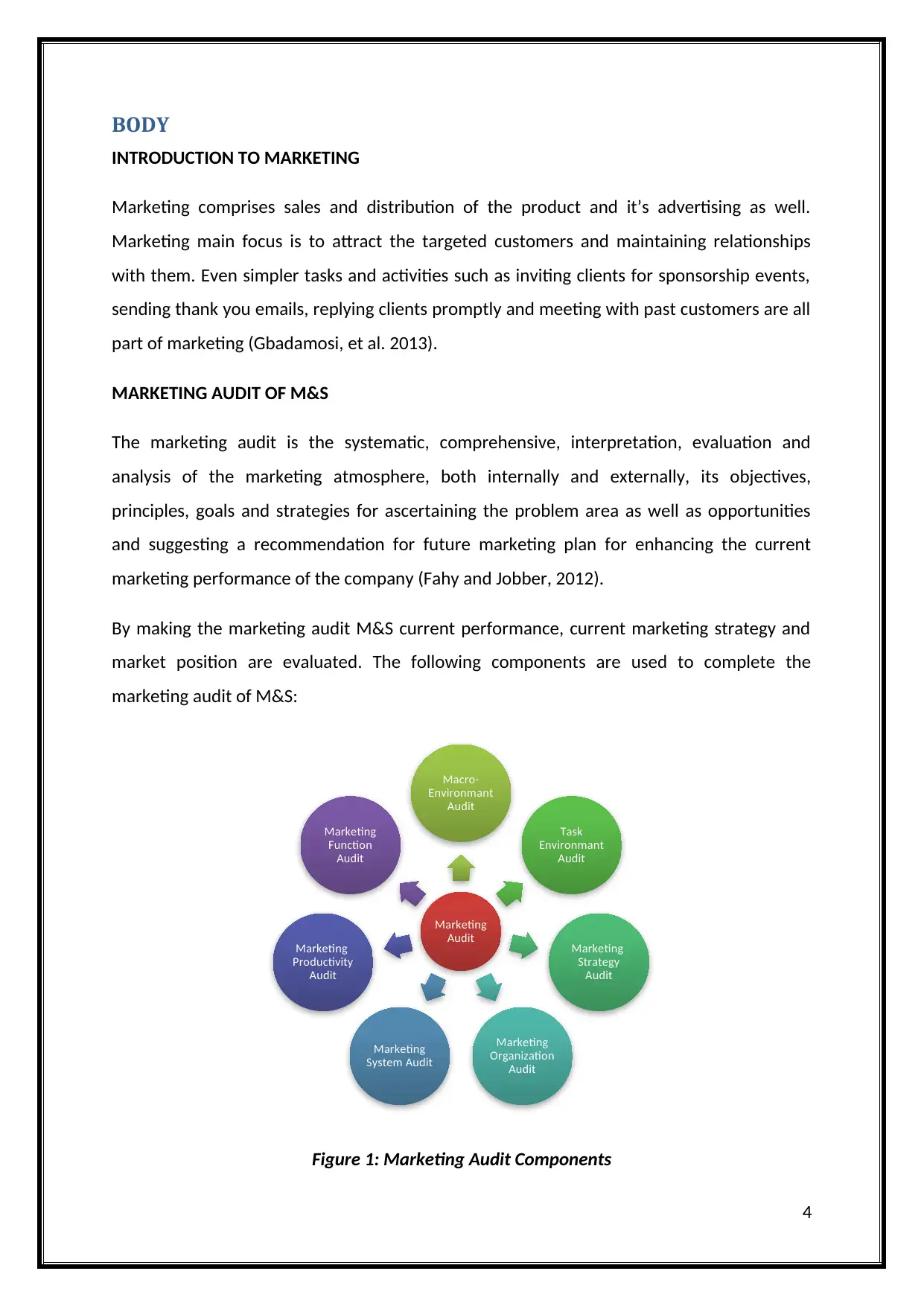
BODY
INTRODUCTION TO MARKETING
Marketing comprises sales and distribution of the product and it’s advertising as well.
Marketing main focus is to attract the targeted customers and maintaining relationships
with them. Even simpler tasks and activities such as inviting clients for sponsorship events,
sending thank you emails, replying clients promptly and meeting with past customers are all
part of marketing (Gbadamosi, et al. 2013).
MARKETING AUDIT OF M&S
The marketing audit is the systematic, comprehensive, interpretation, evaluation and
analysis of the marketing atmosphere, both internally and externally, its objectives,
principles, goals and strategies for ascertaining the problem area as well as opportunities
and suggesting a recommendation for future marketing plan for enhancing the current
marketing performance of the company (Fahy and Jobber, 2012).
By making the marketing audit M&S current performance, current marketing strategy and
market position are evaluated. The following components are used to complete the
marketing audit of M&S:
Figure 1: Marketing Audit Components
4
Marketing
Audit
Macro-
Environmant
Audit
Task
Environmant
Audit
Marketing
Strategy
Audit
Marketing
Organization
Audit
Marketing
System Audit
Marketing
Productivity
Audit
Marketing
Function
Audit
INTRODUCTION TO MARKETING
Marketing comprises sales and distribution of the product and it’s advertising as well.
Marketing main focus is to attract the targeted customers and maintaining relationships
with them. Even simpler tasks and activities such as inviting clients for sponsorship events,
sending thank you emails, replying clients promptly and meeting with past customers are all
part of marketing (Gbadamosi, et al. 2013).
MARKETING AUDIT OF M&S
The marketing audit is the systematic, comprehensive, interpretation, evaluation and
analysis of the marketing atmosphere, both internally and externally, its objectives,
principles, goals and strategies for ascertaining the problem area as well as opportunities
and suggesting a recommendation for future marketing plan for enhancing the current
marketing performance of the company (Fahy and Jobber, 2012).
By making the marketing audit M&S current performance, current marketing strategy and
market position are evaluated. The following components are used to complete the
marketing audit of M&S:
Figure 1: Marketing Audit Components
4
Marketing
Audit
Macro-
Environmant
Audit
Task
Environmant
Audit
Marketing
Strategy
Audit
Marketing
Organization
Audit
Marketing
System Audit
Marketing
Productivity
Audit
Marketing
Function
Audit
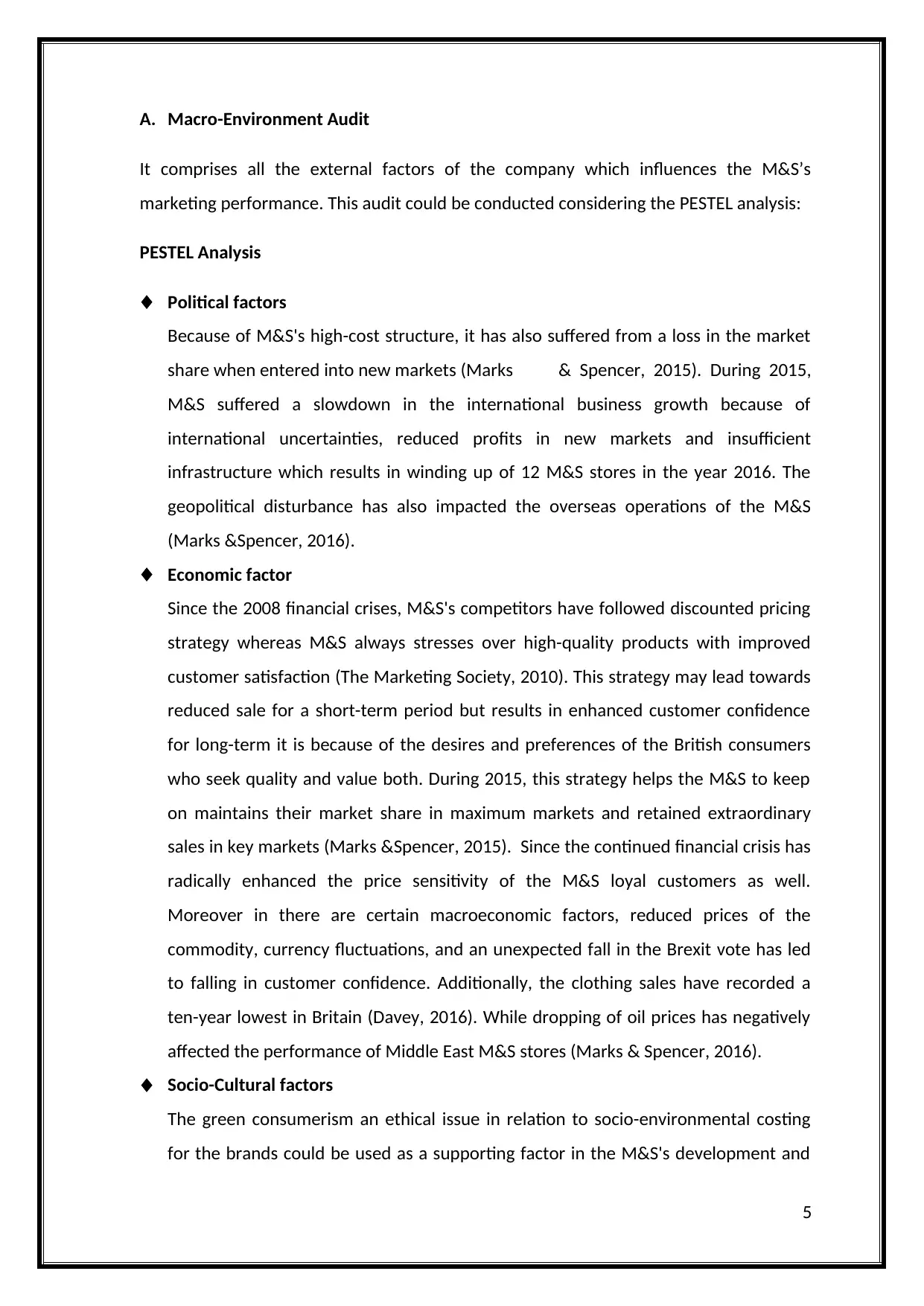
A. Macro-Environment Audit
It comprises all the external factors of the company which influences the M&S’s
marketing performance. This audit could be conducted considering the PESTEL analysis:
PESTEL Analysis
Political factors
Because of M&S's high-cost structure, it has also suffered from a loss in the market
share when entered into new markets (Marks & Spencer, 2015). During 2015,
M&S suffered a slowdown in the international business growth because of
international uncertainties, reduced profits in new markets and insufficient
infrastructure which results in winding up of 12 M&S stores in the year 2016. The
geopolitical disturbance has also impacted the overseas operations of the M&S
(Marks &Spencer, 2016).
Economic factor
Since the 2008 financial crises, M&S's competitors have followed discounted pricing
strategy whereas M&S always stresses over high-quality products with improved
customer satisfaction (The Marketing Society, 2010). This strategy may lead towards
reduced sale for a short-term period but results in enhanced customer confidence
for long-term it is because of the desires and preferences of the British consumers
who seek quality and value both. During 2015, this strategy helps the M&S to keep
on maintains their market share in maximum markets and retained extraordinary
sales in key markets (Marks &Spencer, 2015). Since the continued financial crisis has
radically enhanced the price sensitivity of the M&S loyal customers as well.
Moreover in there are certain macroeconomic factors, reduced prices of the
commodity, currency fluctuations, and an unexpected fall in the Brexit vote has led
to falling in customer confidence. Additionally, the clothing sales have recorded a
ten-year lowest in Britain (Davey, 2016). While dropping of oil prices has negatively
affected the performance of Middle East M&S stores (Marks & Spencer, 2016).
Socio-Cultural factors
The green consumerism an ethical issue in relation to socio-environmental costing
for the brands could be used as a supporting factor in the M&S's development and
5
It comprises all the external factors of the company which influences the M&S’s
marketing performance. This audit could be conducted considering the PESTEL analysis:
PESTEL Analysis
Political factors
Because of M&S's high-cost structure, it has also suffered from a loss in the market
share when entered into new markets (Marks & Spencer, 2015). During 2015,
M&S suffered a slowdown in the international business growth because of
international uncertainties, reduced profits in new markets and insufficient
infrastructure which results in winding up of 12 M&S stores in the year 2016. The
geopolitical disturbance has also impacted the overseas operations of the M&S
(Marks &Spencer, 2016).
Economic factor
Since the 2008 financial crises, M&S's competitors have followed discounted pricing
strategy whereas M&S always stresses over high-quality products with improved
customer satisfaction (The Marketing Society, 2010). This strategy may lead towards
reduced sale for a short-term period but results in enhanced customer confidence
for long-term it is because of the desires and preferences of the British consumers
who seek quality and value both. During 2015, this strategy helps the M&S to keep
on maintains their market share in maximum markets and retained extraordinary
sales in key markets (Marks &Spencer, 2015). Since the continued financial crisis has
radically enhanced the price sensitivity of the M&S loyal customers as well.
Moreover in there are certain macroeconomic factors, reduced prices of the
commodity, currency fluctuations, and an unexpected fall in the Brexit vote has led
to falling in customer confidence. Additionally, the clothing sales have recorded a
ten-year lowest in Britain (Davey, 2016). While dropping of oil prices has negatively
affected the performance of Middle East M&S stores (Marks & Spencer, 2016).
Socio-Cultural factors
The green consumerism an ethical issue in relation to socio-environmental costing
for the brands could be used as a supporting factor in the M&S's development and
5
⊘ This is a preview!⊘
Do you want full access?
Subscribe today to unlock all pages.

Trusted by 1+ million students worldwide
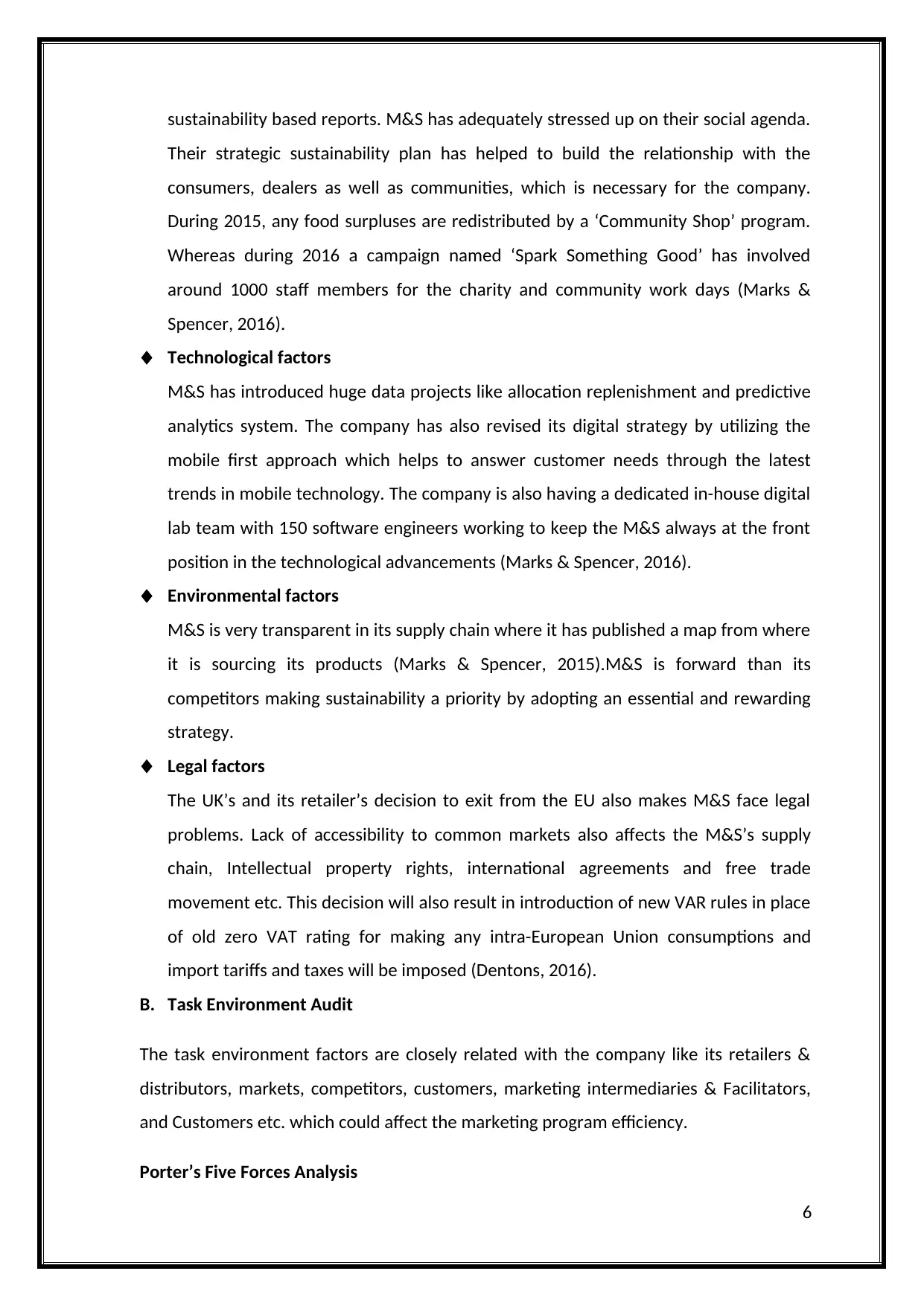
sustainability based reports. M&S has adequately stressed up on their social agenda.
Their strategic sustainability plan has helped to build the relationship with the
consumers, dealers as well as communities, which is necessary for the company.
During 2015, any food surpluses are redistributed by a ‘Community Shop’ program.
Whereas during 2016 a campaign named ‘Spark Something Good’ has involved
around 1000 staff members for the charity and community work days (Marks &
Spencer, 2016).
Technological factors
M&S has introduced huge data projects like allocation replenishment and predictive
analytics system. The company has also revised its digital strategy by utilizing the
mobile first approach which helps to answer customer needs through the latest
trends in mobile technology. The company is also having a dedicated in-house digital
lab team with 150 software engineers working to keep the M&S always at the front
position in the technological advancements (Marks & Spencer, 2016).
Environmental factors
M&S is very transparent in its supply chain where it has published a map from where
it is sourcing its products (Marks & Spencer, 2015).M&S is forward than its
competitors making sustainability a priority by adopting an essential and rewarding
strategy.
Legal factors
The UK’s and its retailer’s decision to exit from the EU also makes M&S face legal
problems. Lack of accessibility to common markets also affects the M&S’s supply
chain, Intellectual property rights, international agreements and free trade
movement etc. This decision will also result in introduction of new VAR rules in place
of old zero VAT rating for making any intra-European Union consumptions and
import tariffs and taxes will be imposed (Dentons, 2016).
B. Task Environment Audit
The task environment factors are closely related with the company like its retailers &
distributors, markets, competitors, customers, marketing intermediaries & Facilitators,
and Customers etc. which could affect the marketing program efficiency.
Porter’s Five Forces Analysis
6
Their strategic sustainability plan has helped to build the relationship with the
consumers, dealers as well as communities, which is necessary for the company.
During 2015, any food surpluses are redistributed by a ‘Community Shop’ program.
Whereas during 2016 a campaign named ‘Spark Something Good’ has involved
around 1000 staff members for the charity and community work days (Marks &
Spencer, 2016).
Technological factors
M&S has introduced huge data projects like allocation replenishment and predictive
analytics system. The company has also revised its digital strategy by utilizing the
mobile first approach which helps to answer customer needs through the latest
trends in mobile technology. The company is also having a dedicated in-house digital
lab team with 150 software engineers working to keep the M&S always at the front
position in the technological advancements (Marks & Spencer, 2016).
Environmental factors
M&S is very transparent in its supply chain where it has published a map from where
it is sourcing its products (Marks & Spencer, 2015).M&S is forward than its
competitors making sustainability a priority by adopting an essential and rewarding
strategy.
Legal factors
The UK’s and its retailer’s decision to exit from the EU also makes M&S face legal
problems. Lack of accessibility to common markets also affects the M&S’s supply
chain, Intellectual property rights, international agreements and free trade
movement etc. This decision will also result in introduction of new VAR rules in place
of old zero VAT rating for making any intra-European Union consumptions and
import tariffs and taxes will be imposed (Dentons, 2016).
B. Task Environment Audit
The task environment factors are closely related with the company like its retailers &
distributors, markets, competitors, customers, marketing intermediaries & Facilitators,
and Customers etc. which could affect the marketing program efficiency.
Porter’s Five Forces Analysis
6
Paraphrase This Document
Need a fresh take? Get an instant paraphrase of this document with our AI Paraphraser
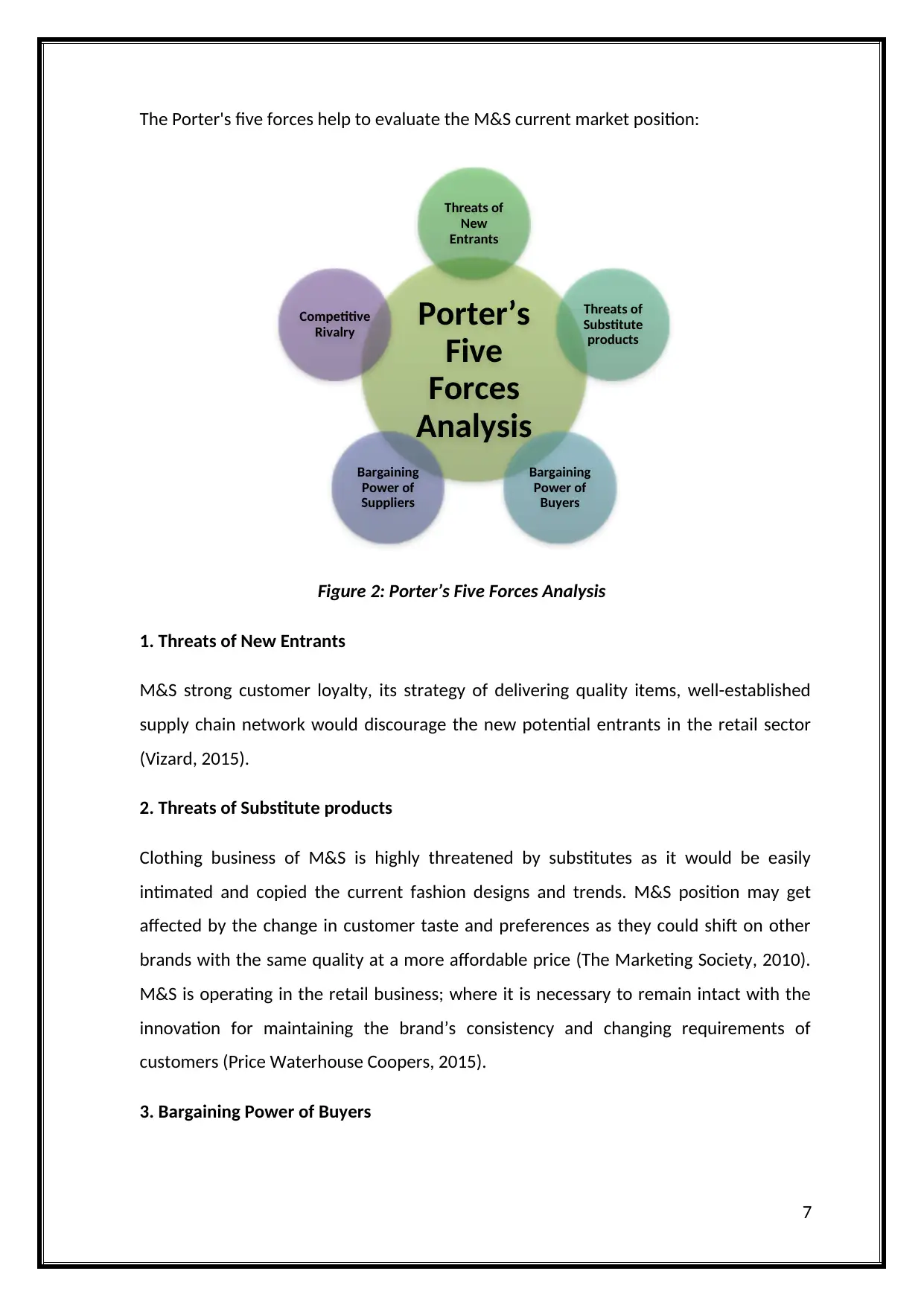
The Porter's five forces help to evaluate the M&S current market position:
Figure 2: Porter’s Five Forces Analysis
1. Threats of New Entrants
M&S strong customer loyalty, its strategy of delivering quality items, well-established
supply chain network would discourage the new potential entrants in the retail sector
(Vizard, 2015).
2. Threats of Substitute products
Clothing business of M&S is highly threatened by substitutes as it would be easily
intimated and copied the current fashion designs and trends. M&S position may get
affected by the change in customer taste and preferences as they could shift on other
brands with the same quality at a more affordable price (The Marketing Society, 2010).
M&S is operating in the retail business; where it is necessary to remain intact with the
innovation for maintaining the brand’s consistency and changing requirements of
customers (Price Waterhouse Coopers, 2015).
3. Bargaining Power of Buyers
7
Porter’s
Five
Forces
Analysis
Threats of
New
Entrants
Threats of
Substitute
products
Bargaining
Power of
Buyers
Bargaining
Power of
Suppliers
Competitive
Rivalry
Figure 2: Porter’s Five Forces Analysis
1. Threats of New Entrants
M&S strong customer loyalty, its strategy of delivering quality items, well-established
supply chain network would discourage the new potential entrants in the retail sector
(Vizard, 2015).
2. Threats of Substitute products
Clothing business of M&S is highly threatened by substitutes as it would be easily
intimated and copied the current fashion designs and trends. M&S position may get
affected by the change in customer taste and preferences as they could shift on other
brands with the same quality at a more affordable price (The Marketing Society, 2010).
M&S is operating in the retail business; where it is necessary to remain intact with the
innovation for maintaining the brand’s consistency and changing requirements of
customers (Price Waterhouse Coopers, 2015).
3. Bargaining Power of Buyers
7
Porter’s
Five
Forces
Analysis
Threats of
New
Entrants
Threats of
Substitute
products
Bargaining
Power of
Buyers
Bargaining
Power of
Suppliers
Competitive
Rivalry
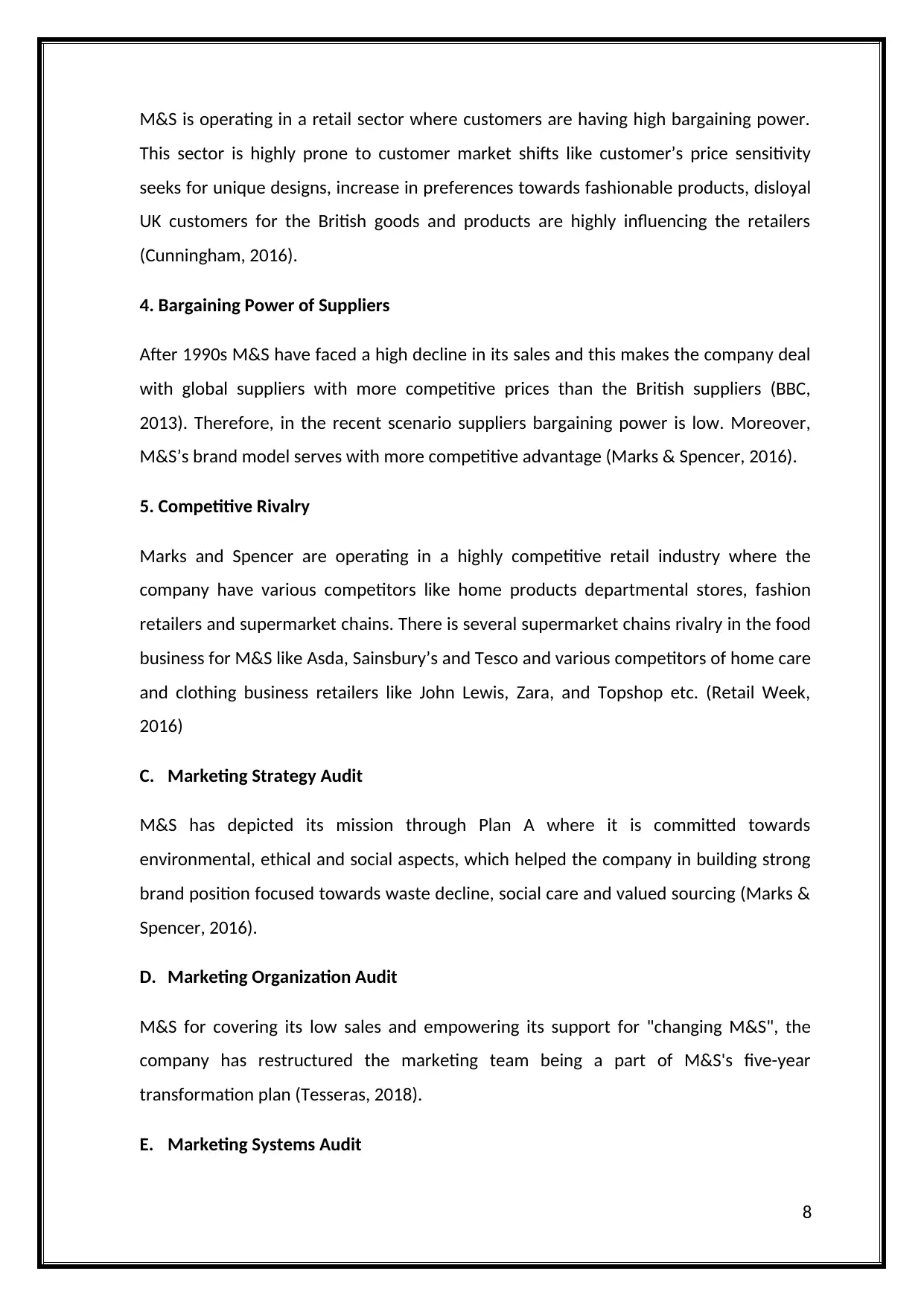
M&S is operating in a retail sector where customers are having high bargaining power.
This sector is highly prone to customer market shifts like customer’s price sensitivity
seeks for unique designs, increase in preferences towards fashionable products, disloyal
UK customers for the British goods and products are highly influencing the retailers
(Cunningham, 2016).
4. Bargaining Power of Suppliers
After 1990s M&S have faced a high decline in its sales and this makes the company deal
with global suppliers with more competitive prices than the British suppliers (BBC,
2013). Therefore, in the recent scenario suppliers bargaining power is low. Moreover,
M&S’s brand model serves with more competitive advantage (Marks & Spencer, 2016).
5. Competitive Rivalry
Marks and Spencer are operating in a highly competitive retail industry where the
company have various competitors like home products departmental stores, fashion
retailers and supermarket chains. There is several supermarket chains rivalry in the food
business for M&S like Asda, Sainsbury’s and Tesco and various competitors of home care
and clothing business retailers like John Lewis, Zara, and Topshop etc. (Retail Week,
2016)
C. Marketing Strategy Audit
M&S has depicted its mission through Plan A where it is committed towards
environmental, ethical and social aspects, which helped the company in building strong
brand position focused towards waste decline, social care and valued sourcing (Marks &
Spencer, 2016).
D. Marketing Organization Audit
M&S for covering its low sales and empowering its support for "changing M&S", the
company has restructured the marketing team being a part of M&S's five-year
transformation plan (Tesseras, 2018).
E. Marketing Systems Audit
8
This sector is highly prone to customer market shifts like customer’s price sensitivity
seeks for unique designs, increase in preferences towards fashionable products, disloyal
UK customers for the British goods and products are highly influencing the retailers
(Cunningham, 2016).
4. Bargaining Power of Suppliers
After 1990s M&S have faced a high decline in its sales and this makes the company deal
with global suppliers with more competitive prices than the British suppliers (BBC,
2013). Therefore, in the recent scenario suppliers bargaining power is low. Moreover,
M&S’s brand model serves with more competitive advantage (Marks & Spencer, 2016).
5. Competitive Rivalry
Marks and Spencer are operating in a highly competitive retail industry where the
company have various competitors like home products departmental stores, fashion
retailers and supermarket chains. There is several supermarket chains rivalry in the food
business for M&S like Asda, Sainsbury’s and Tesco and various competitors of home care
and clothing business retailers like John Lewis, Zara, and Topshop etc. (Retail Week,
2016)
C. Marketing Strategy Audit
M&S has depicted its mission through Plan A where it is committed towards
environmental, ethical and social aspects, which helped the company in building strong
brand position focused towards waste decline, social care and valued sourcing (Marks &
Spencer, 2016).
D. Marketing Organization Audit
M&S for covering its low sales and empowering its support for "changing M&S", the
company has restructured the marketing team being a part of M&S's five-year
transformation plan (Tesseras, 2018).
E. Marketing Systems Audit
8
⊘ This is a preview!⊘
Do you want full access?
Subscribe today to unlock all pages.

Trusted by 1+ million students worldwide
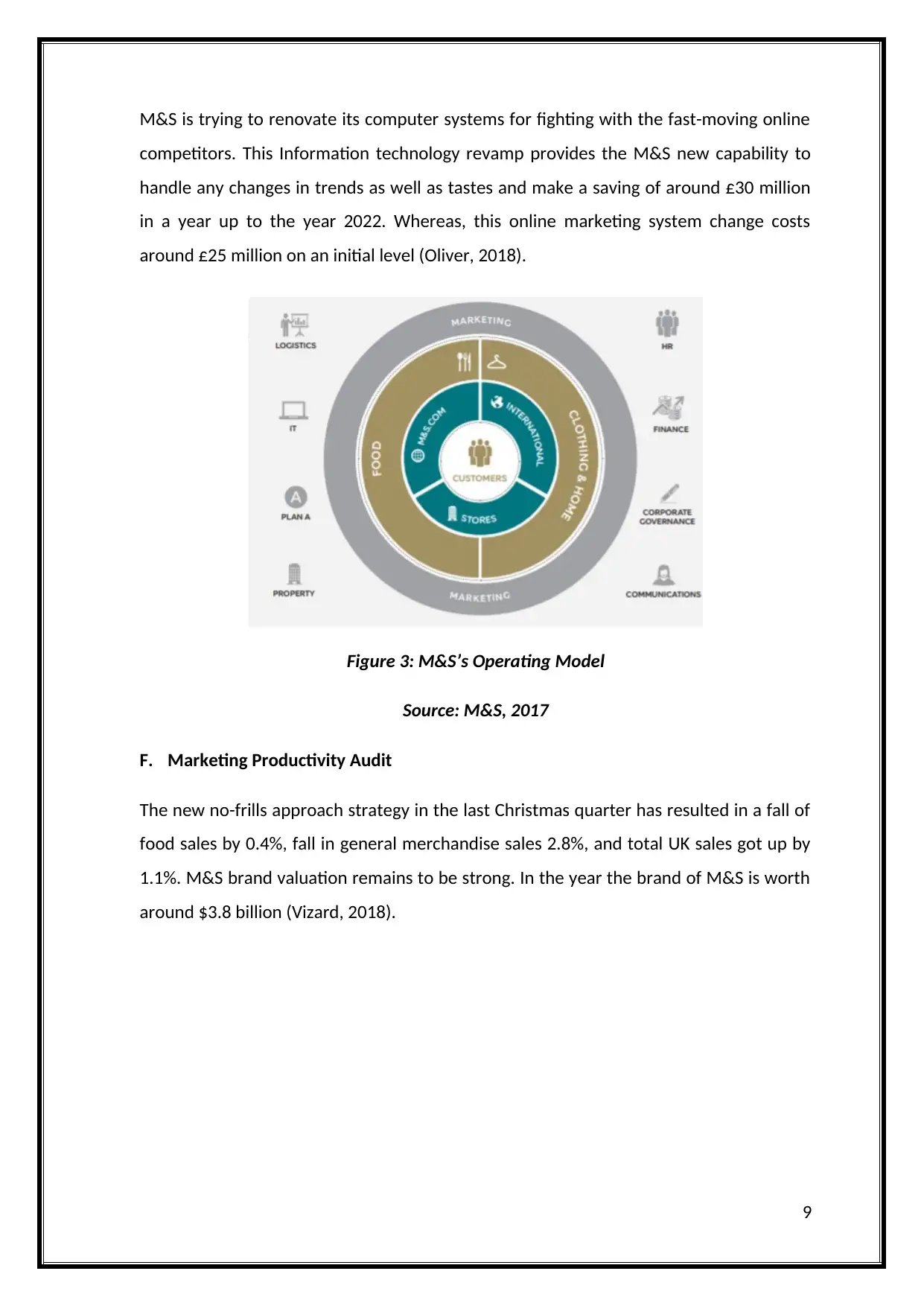
M&S is trying to renovate its computer systems for fighting with the fast-moving online
competitors. This Information technology revamp provides the M&S new capability to
handle any changes in trends as well as tastes and make a saving of around £30 million
in a year up to the year 2022. Whereas, this online marketing system change costs
around £25 million on an initial level (Oliver, 2018).
Figure 3: M&S’s Operating Model
Source: M&S, 2017
F. Marketing Productivity Audit
The new no-frills approach strategy in the last Christmas quarter has resulted in a fall of
food sales by 0.4%, fall in general merchandise sales 2.8%, and total UK sales got up by
1.1%. M&S brand valuation remains to be strong. In the year the brand of M&S is worth
around $3.8 billion (Vizard, 2018).
9
competitors. This Information technology revamp provides the M&S new capability to
handle any changes in trends as well as tastes and make a saving of around £30 million
in a year up to the year 2022. Whereas, this online marketing system change costs
around £25 million on an initial level (Oliver, 2018).
Figure 3: M&S’s Operating Model
Source: M&S, 2017
F. Marketing Productivity Audit
The new no-frills approach strategy in the last Christmas quarter has resulted in a fall of
food sales by 0.4%, fall in general merchandise sales 2.8%, and total UK sales got up by
1.1%. M&S brand valuation remains to be strong. In the year the brand of M&S is worth
around $3.8 billion (Vizard, 2018).
9
Paraphrase This Document
Need a fresh take? Get an instant paraphrase of this document with our AI Paraphraser
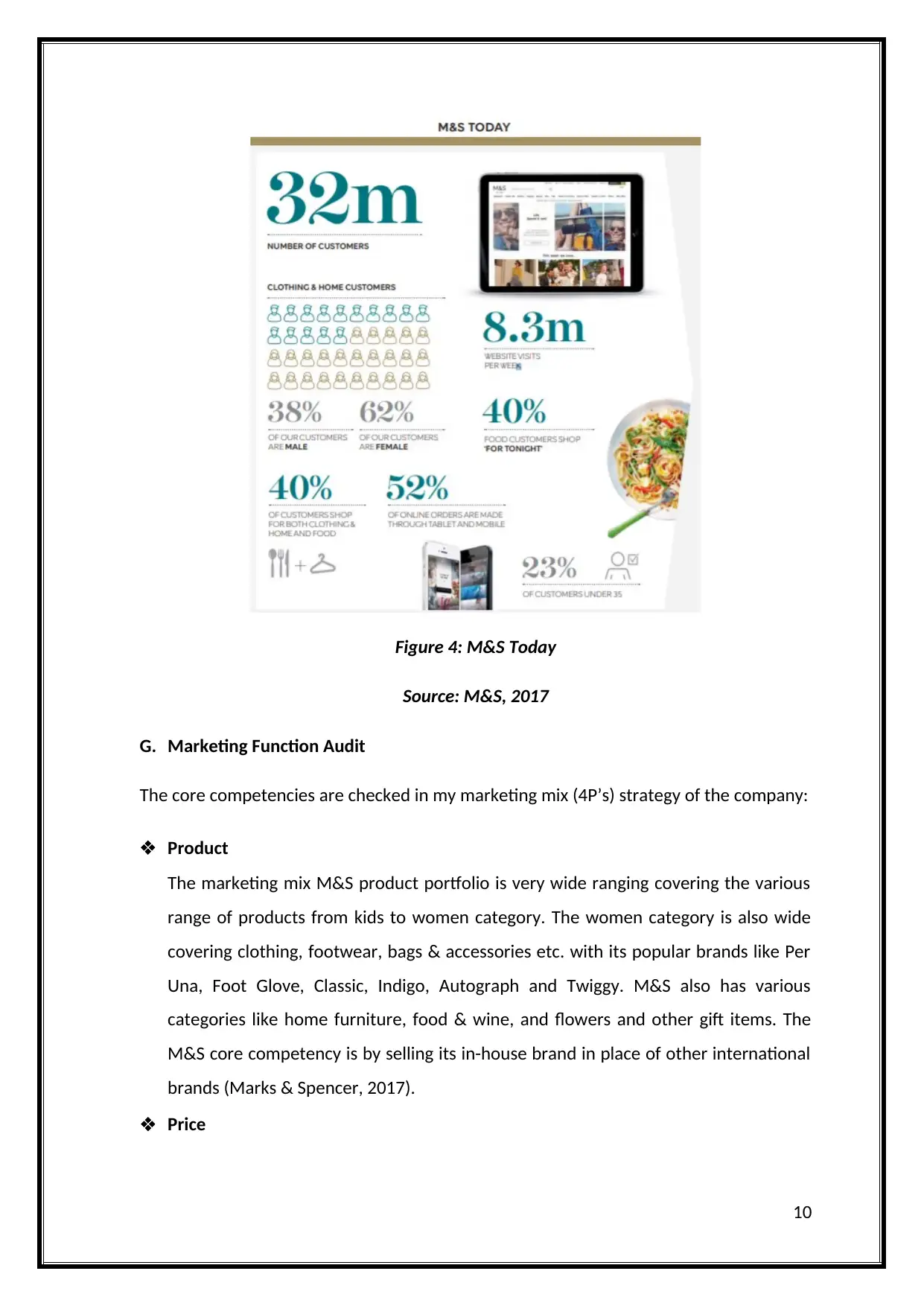
Figure 4: M&S Today
Source: M&S, 2017
G. Marketing Function Audit
The core competencies are checked in my marketing mix (4P’s) strategy of the company:
Product
The marketing mix M&S product portfolio is very wide ranging covering the various
range of products from kids to women category. The women category is also wide
covering clothing, footwear, bags & accessories etc. with its popular brands like Per
Una, Foot Glove, Classic, Indigo, Autograph and Twiggy. M&S also has various
categories like home furniture, food & wine, and flowers and other gift items. The
M&S core competency is by selling its in-house brand in place of other international
brands (Marks & Spencer, 2017).
Price
10
Source: M&S, 2017
G. Marketing Function Audit
The core competencies are checked in my marketing mix (4P’s) strategy of the company:
Product
The marketing mix M&S product portfolio is very wide ranging covering the various
range of products from kids to women category. The women category is also wide
covering clothing, footwear, bags & accessories etc. with its popular brands like Per
Una, Foot Glove, Classic, Indigo, Autograph and Twiggy. M&S also has various
categories like home furniture, food & wine, and flowers and other gift items. The
M&S core competency is by selling its in-house brand in place of other international
brands (Marks & Spencer, 2017).
Price
10
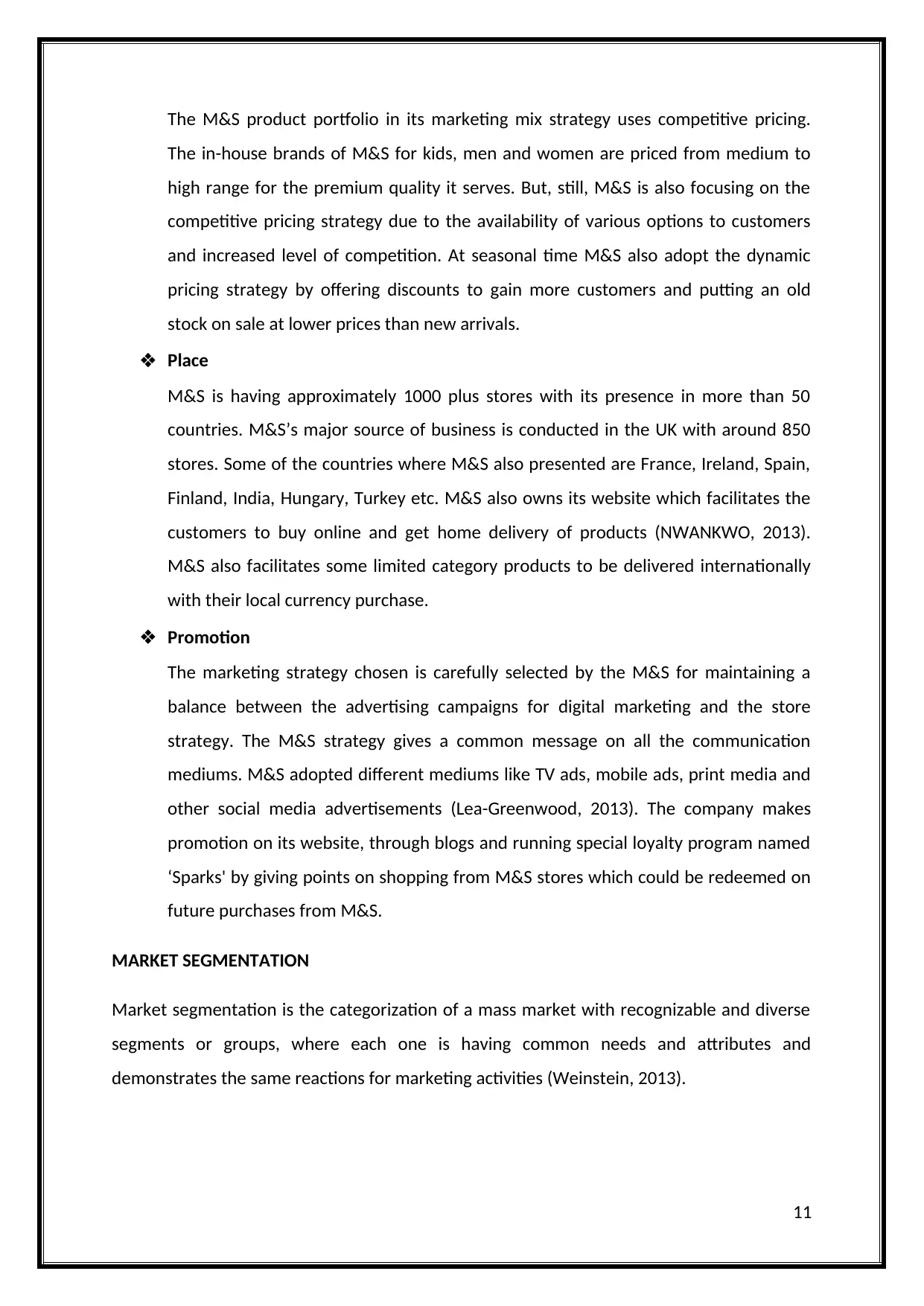
The M&S product portfolio in its marketing mix strategy uses competitive pricing.
The in-house brands of M&S for kids, men and women are priced from medium to
high range for the premium quality it serves. But, still, M&S is also focusing on the
competitive pricing strategy due to the availability of various options to customers
and increased level of competition. At seasonal time M&S also adopt the dynamic
pricing strategy by offering discounts to gain more customers and putting an old
stock on sale at lower prices than new arrivals.
Place
M&S is having approximately 1000 plus stores with its presence in more than 50
countries. M&S’s major source of business is conducted in the UK with around 850
stores. Some of the countries where M&S also presented are France, Ireland, Spain,
Finland, India, Hungary, Turkey etc. M&S also owns its website which facilitates the
customers to buy online and get home delivery of products (NWANKWO, 2013).
M&S also facilitates some limited category products to be delivered internationally
with their local currency purchase.
Promotion
The marketing strategy chosen is carefully selected by the M&S for maintaining a
balance between the advertising campaigns for digital marketing and the store
strategy. The M&S strategy gives a common message on all the communication
mediums. M&S adopted different mediums like TV ads, mobile ads, print media and
other social media advertisements (Lea-Greenwood, 2013). The company makes
promotion on its website, through blogs and running special loyalty program named
‘Sparks' by giving points on shopping from M&S stores which could be redeemed on
future purchases from M&S.
MARKET SEGMENTATION
Market segmentation is the categorization of a mass market with recognizable and diverse
segments or groups, where each one is having common needs and attributes and
demonstrates the same reactions for marketing activities (Weinstein, 2013).
11
The in-house brands of M&S for kids, men and women are priced from medium to
high range for the premium quality it serves. But, still, M&S is also focusing on the
competitive pricing strategy due to the availability of various options to customers
and increased level of competition. At seasonal time M&S also adopt the dynamic
pricing strategy by offering discounts to gain more customers and putting an old
stock on sale at lower prices than new arrivals.
Place
M&S is having approximately 1000 plus stores with its presence in more than 50
countries. M&S’s major source of business is conducted in the UK with around 850
stores. Some of the countries where M&S also presented are France, Ireland, Spain,
Finland, India, Hungary, Turkey etc. M&S also owns its website which facilitates the
customers to buy online and get home delivery of products (NWANKWO, 2013).
M&S also facilitates some limited category products to be delivered internationally
with their local currency purchase.
Promotion
The marketing strategy chosen is carefully selected by the M&S for maintaining a
balance between the advertising campaigns for digital marketing and the store
strategy. The M&S strategy gives a common message on all the communication
mediums. M&S adopted different mediums like TV ads, mobile ads, print media and
other social media advertisements (Lea-Greenwood, 2013). The company makes
promotion on its website, through blogs and running special loyalty program named
‘Sparks' by giving points on shopping from M&S stores which could be redeemed on
future purchases from M&S.
MARKET SEGMENTATION
Market segmentation is the categorization of a mass market with recognizable and diverse
segments or groups, where each one is having common needs and attributes and
demonstrates the same reactions for marketing activities (Weinstein, 2013).
11
⊘ This is a preview!⊘
Do you want full access?
Subscribe today to unlock all pages.

Trusted by 1+ million students worldwide
1 out of 20
Related Documents
Your All-in-One AI-Powered Toolkit for Academic Success.
+13062052269
info@desklib.com
Available 24*7 on WhatsApp / Email
![[object Object]](/_next/static/media/star-bottom.7253800d.svg)
Unlock your academic potential
Copyright © 2020–2025 A2Z Services. All Rights Reserved. Developed and managed by ZUCOL.




